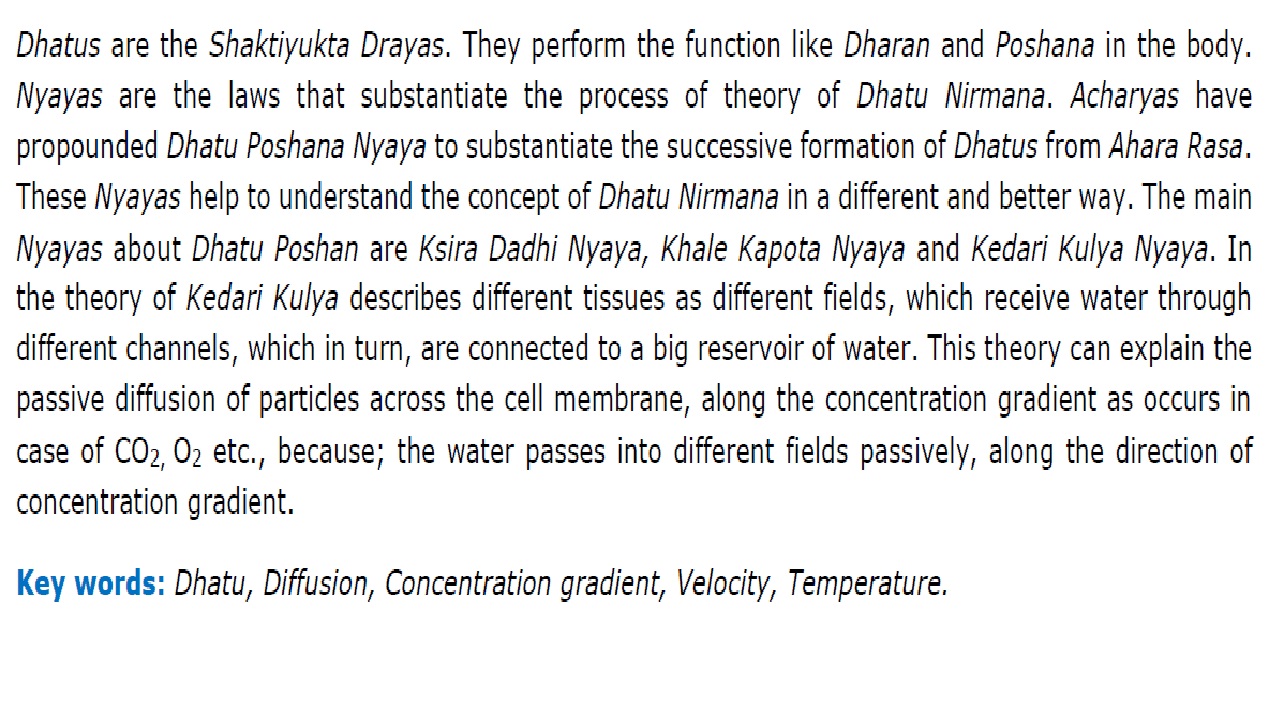Physiological study of Kedari Kulya Nyaya in reference to transport of Particles through Cell Membrane
Keywords:
Ayurveda, Dhatu, Diffusion, Concentration gradient, Velocity, TemperatureAbstract
Dhatus are the Shaktiyukta Drayas. They perform the function like Dharan and Poshana in the body. Nyayas are the laws that substantiate the process of theory of Dhatu Nirmana. Acharyas have propounded Dhatu Poshana Nyaya to substantiate the successive formation of Dhatus from Ahara Rasa. These Nyayas help to understand the concept of Dhatu Nirmana in a different and better way. The main Nyayas about Dhatu Poshan are Ksira Dadhi Nyaya, Khale Kapota Nyaya and Kedari Kulya Nyaya. In the theory of Kedari Kulya describes different tissues as different fields, which receive water through different channels, which in turn, are connected to a big reservoir of water. This theory can explain the passive diffusion of particles across the cell membrane, along the concentration gradient as occurs in case of CO2, O2 etc., because; the water passes into different fields passively, along the direction of concentration gradient.
Downloads
References
Prof. S.B. Kotur, A Text Book of Ayurvedic Physiology, Chaukhambha Orientalia, Reprint edition 2017, Page no. 186.
Prof. Dr. Yogesh Chandra Mishra, Ayurvediya Kriya Sharira Vol. 1, Chaukhambha Publications New Delhi, Edition Reprint 2017, page no. 435.
Charaka Samhita (text with English translation & critical Exposition based on Chakrapani Datta Ayurveda Dipika) Vol IV (chikitsa sthana 15/16) edited by R. K Sharma and Bhagwan Das, Chaukhambha Sanskrit series Office Varanasi (India), Reprint 2016.
Prof. Kishor Patwardhan, A Text Book of Ayurvedic Human Physiology, Chaukhambha Orientalia Varanasi, first edition 2018, page no. 323.
Charaka Samhita (text with English translation & critical Exposition based on Chakrapani Datta Ayurveda Dipika) Vol 1 (sutra sthana 28/4) edited by R. K Sharma and Bhagwan das , Chaukhambha Sanskrit series Office Varanasi (India), Reprint 2016.
Illustrated Sushruta Samhita (Text, English Translation. Notes, Appendices and Index) Vol 1(sutra sthana14/10) Translator Prof. K.R Srikantha Murthy, Chaukhambha Orientalia, Varanasi, reprint 2016.
Charaka Samhita (text with English translation & critical Exposition based on Chakrapani Datta Ayurveda Dipika) Vol IV (chikitsa sthana 15/16) edited by R. K Sharma and Bhagwan Das, Chaukhambha Sanskrit series Office Varanasi (India), Reprint 2016.
Prof. Dr. Yogesh Chandra Mishra, Ayurvediya Kriya Sharira Vol. 1, Chaukhambha Publications New Delhi, Edition Reprint 2017, page no. 435.
Illustrated Sushruta Samhita (Text, English Translation. Notes, Appendices and Index) Vol 1(sutra sthana 14/14) Translator Prof. K.R Srikantha Murthy, Chaukhambha Orientalia, Varanasi, reprint 2016.
Prof. Dr. Subhash Ranade, A Text Book of Kriya Sharira Part-2 Chaukhambha Sanskrit Pratishthan Delhi, Reprint 2019. Page no. 22.
Dr. Kishor Patwardhan, Human Physiology in Ayurveda, Chaukhambha Orientalia Varanasi, reprint edition 2016, page no. 40.
Dr. Kishor Patwardhan, Human Physiology in Ayurveda, Chaukhambha Orientalia Varanasi, reprint edition 2016, page no. 41.
K Sembulingam and Prema Sembulingam, Essentials of Medical Physiology, Seventh Edition Jaypee Brothers Medical Publishers (P) Ltd. New Delhi. Page no. 31.
Arthur C. Guyton and John E. Hall, TextBook of Medical Physiology, tenth edition, Harcourt Asia Pte. Ltd., Page no. 39.
Sujit K. Chaudhuri, Concise Medical Physiology, third edition 2001, New central Book Agency (P) Ltd. Page no. 6.
K Sembulingam and Prema Sembulingam, Essentials of Medical Physiology, Seventh Edition Jaypee Brothers Medical Publishers (P) Ltd. New Delhi. Page no. 31-34.















